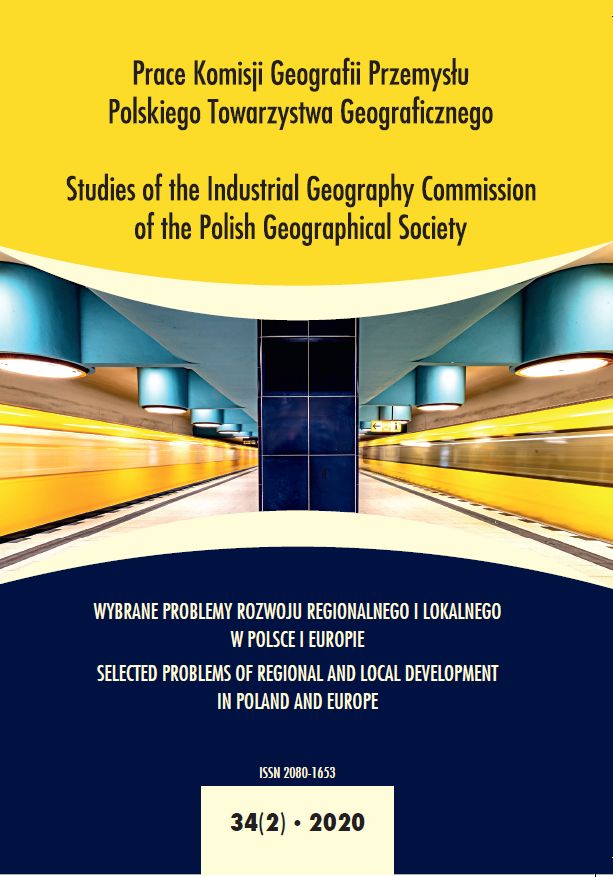Innovation distance of Polish regions in relation to European models
DOI:
https://doi.org/10.24917/20801653.342.1Keywords:
high technology, innovation level, R&D sector, region, relative technological comparative advantageAbstract
This article deals with the subject of the level of innovative development that is characteristic ofPolish regions in comparison with other nations of the European Union. Among the main measures of innovation, the following factors were taken into account: patent activity, employment in the R&D sector, expenditure on R&D, and human resources for science and technology. Based on numerous studies indicating that this is an issue, an attempt has been made to measure the innovation gap in spatial and dynamic terms using a number of statistical tools. The innovation gap index, the innovation level change index and the patent advantage indicator were used as measures. Each of these methods takes into account certain measures of innovation (and their different approaches), which allows the problem to be comprehensively studied. Statistical data from the Eurostat, OECD and EPO databases for 2009-2017, which are related to the availability of data presented in regional innovation rankings, were used in the study. The results clearly show a disproportion in the development of Polish regions in relation to their European counterparts, but also in the direction of change over recent years. There are in addition symptoms of positive changes illustrated by detailed assessments of the indicators examined for selected Polish regions.
Downloads
Metrics
References
Acs, Z.J., Anselin, L., Varga, A., (2002). Patents and Innovation Count as Measures of Regional Production of New Knowledge. Research Policy, 31, 1069–1085. doi: 10.1016/S0048-7333(01)00184-6
Bolívar -Ramos, M.T. (2017). The relation between R&D spending and patents: The moderating effect of collaboration networks. Journal of Engineering and Technology Management, 46, 26–38. doi: 10.1016/j.jengtecman.2017.11.001
Cirera, X., Maloney, W.F. (2017). The Innovation Paradox, The World Bank. doi: 10.1596/978-1-4648-1160-9
Djellal, F., Gallouj, F. (2008). The innovation gap, the performance gap and the policy gap in services, chap. 27. In: Gallouj F, Djellal F (eds.) The handbook of innovation and services: a multidisciplinary perspective. Edward Elgar Publishers, Cheltenham, 653–675.
Fernandes, C., Ferreira, J.J., Marques, C.S., (2015). Innovation management capabilities in rural and urban knowledge -intensive business services: empirical evidence. Service Business. 9, 233–256. doi: 10.1007/s11628-013-0225-7
Firlej, K.A. (2013). Innowacyjność jako instrument podnoszenia konkurencyjności regionów. Roczniki Ekonomiczne Kujawsko ‑Pomorskiej Szkoły Wyższej w Bydgoszczy, 6, 211–221.
Fritsch, M., Franke, G. (2004). Innovation, regional knowledge spillovers and R&D cooperation. Research Policy, 33, 245–255. doi: 10.1016/S0048-7333(03)00123-9
Godin, B. (2011). Taking Statistics (More) Seriously: The Measurement of Science, Technology and Innovation and its Future. Montreal: Centre- Urbanisation Culture Societe de L’Institut national de Ia recherche Scientifique.
Hong, J., Zhou, Ch., Wu, Y., Wang, R., Marinova, D., (2019). Technology Gap, Reverse Technology Spillover and Domestic Innovation Performance in Outward Foreign Direct Investment: Evidence from China. China & World Economy, 27(2), 1–23. doi: 10.1111/cwe.12272
Huber, D., Kaufmann, H., Steinmann, M. (2014). Bridging the Innovation Gap. Springer. doi: 10.1007/978-3-319-55498-3
Mesjasz -Lech, A. (2016). Inequality of the development of entrepreneurship and innovation in Poland. Organizacja i Zarządzanie, 3, 97–110.
NESTA (2006). The Innovation Gap: Why policy needs to reflect the reality of innovation in the UK. National Endowment for Science, Technology and Arts, Research Report.
Regional Innovation Scoreboard (RIS) 2009 (2009). European Communities. Regional Innovation Scoreboard (RIS) 2017 (2017). European Communities.
Rogers, M. (1998). The Definition and Measurement of Innovation. (Working Paper) Melbourne Institute.
Schienstock, G., Hamalainen, T. (2001). Transformation of the Finnish Innovation System: A Network Approach. Helsinki: Sitra Reports, 7.
Sobczak, E. (2013). Efekty strukturalne zmian zatrudnienia według sektorów zaawansowania technologicznego w regionach europejskich. Prace Naukowe Uniwersytetu Ekonomicznego we Wrocławiu, 285, 123–133.
Strahl, D. (red.). (2010). Innowacyjność europejskiej przestrzeni regionalnej a dynamika rozwoju gospodarczego. Wrocław: Wydawnictwo Uniwersytetu Ekonomicznego we Wrocławiu.
Weresa, M. (2014). Polityka innowacyjna. Warszawa: PWN.
Zawada, M., Herbuś, I. (2014). Innowacje drogą do zintensyfikowania rozwoju województw. Zeszyty Naukowe Politechniki Częstochowskie.j Zarządzanie, 14, 35–45.
Zioło, Z. (2012). Miejsce innowacyjności w kształtowaniu procesów rozwoju gospodarczego układów przestrzennych. Prace Komisji Geografii Przemysłu Polskiego Towarzystwa Geograficznego [Studies of the Industrial Geography Commission of the Polish Geographical Society], 20, 9–32.
Downloads
Published
How to Cite
Issue
Section
License
Articles are published under the terms of the Creative Commons License (CC BY-ND 4.0; Attribution– NoDerivs).

